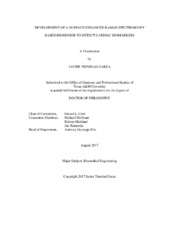| dc.description.abstract | Myocardial infarction (MI) is one of the most common causes of death in the world. The main symptom after the onset of MI is chest pain, which is one of the leading reasons for emergency department (ED) visits. When a patient arrives to the ED with chest pain, a rapid and accurate diagnosis is essential to immediately start the appropriate treatment. The measurement of cardiac biomarkers plays a key role in the diagnosis process, and improvements in this field could have a significant positive impact in the health of patients. Therefore, the development of fast, sensitive, and precise technologies to measure cardiac biomarkers is of great interest.
This work focuses in the development of a surface enhanced Raman spectroscopy (SERS)-based assay to detect cardiac biomarkers. SERS is an attractive technique because it exhibits multiplexing and high sensitivity capabilities. Several SERS active nanoparticles were synthesized and functionalized with antibodies to use them in assays. They were characterized and compared to select the nanoprobe that exhibited stability, intense SERS signal, and functionality. In addition, various techniques to collect nanoparticles were examined. A device and method to consistently collect nanoparticles for SERS measurements was developed, which allowed to detect nanoprobe samples (10 μL) across a range from nearly 27.4 fM to 1.7 pM with less than 10 % coefficient of variation (CV). Different assay formats were considered to implement the assay with the desired sensitivity and precision. After synthesizing the assay components, building the collection device, and selecting the sandwich assay format, an assay to detect cardiac troponin I (cTnI) was developed and tested. Various assay conditions were optimized to improve the signal. Finally, a concentration curve that exhibited the expected response trend was obtained. | en |


